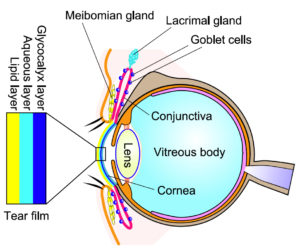Very long-chain lipids could help prevent dry eye disease
Research Press Release | February 13, 2018
Joint press release by Hokkaido University and Japan Agency for Medical Research and Development (AMED).
Very long-chain lipids in the most superficial layer of the tear film cause severe dry eye disease when they were shortened in mice — a result that could help develop new drugs for the disease.
With computers, smartphones and contact lenses now essential to modern life, many — one out of every 10 Japanese people — suffer dry eye disease.
The tear film performs various functions, including maintaining a smooth surface for light refraction, lubricating the cornea and conjunctiva, and supplying the cornea with oxygen and nutrients. Many might think tears are merely water, but actually the tear film is composed of three basic layers: mucin, water and lipids, the latter of which helps prevent water evaporation from the ocular surface and protects against infection.
About 80 percent of dry eye disease cases are caused by abnormalities in this lipid layer. Although drugs targeting the water and mucin layers are available, no drug has been manufactured to target the lipid layer.
Tear film lipids are secreted by the meibomian gland and are called meibum, a molecular chain composed of cholesteryl esters and wax esters. The meibum carbon chain is generally very long, having from 20 to 34 constituent carbons. But much about meibum remains unclear, such as the significance of its long chains and its role in preventing dry eye disease.
The research team led by Akio Kihara of Hokkaido University created mice whose Elovl1 gene, which encodes an enzyme that elongates fatty acid chains, was deleted from everywhere but the skin, knowing that knocking out the gene in the skin is lethal. The team observed that when young, the knockout mice blinked frequently and exhibited signs of dry eye disease, such as increased water evaporation from the tear film. After five months, many of the mice developed cloudy corneas. The corneal abnormalities are believed to have been caused by prolonged dry eyes, which inhibited self-repair of the damaged cornea.
The researchers also found that the knockout mice had less very long-chain meibum (≥ 25 carbons), but more short-chain meibum.
These results indicate Elovl1 is closely linked to the synthesis of very long-chain meibum, which appear to be essential to preventing dry eye disease. “Our results could help develop new drugs to treat and prevent the dry eye disease, such as agents that promote the secretion of very long-chain meibum or eye drops containing these lipids,” says Kihara.
The present study was conducted in collaboration with RIKEN Center for Life Science Technologies as a part of the “Studies on the Functions of Lipid Molecules to Develop Innovative Medical Technologies” project sponsored by Japan Agency for Medical Research and Development (AMED).
Original article:
Sassa T., Tadaki M., Kiyonari H., Kihara A. Very long-chain tear film lipids produced by fatty acid elongase ELOVL1 prevent dry eye disease in mice, FASEB Journal, January 17, 2018.
DOI: 10.1096/fj.201700947R
Contacts:
Professor Akio Kihara
Faculty of Pharmaceutical Sciences
Hokkaido University
Email: kihara[at]pharm.hokudai.ac.jp
http://www.pharm.hokudai.ac.jp/seika/english%20pages/e_top.html
Naoki Namba (Media Officer)
Global Relations Office
Institute for International Collaboration
Hokkaido University
Tel: +81-11-706-2185
Email: pr[at]oia.hokudai.ac.jp


